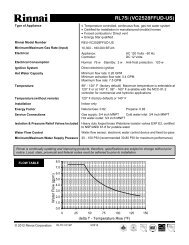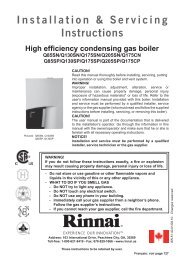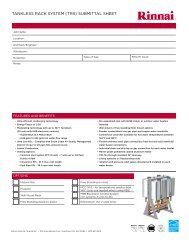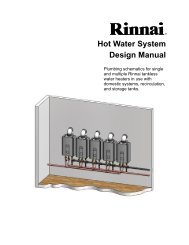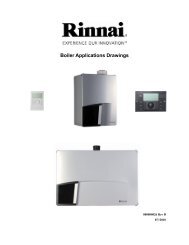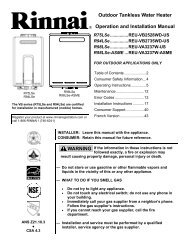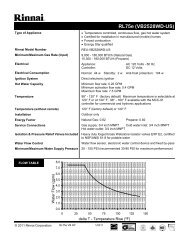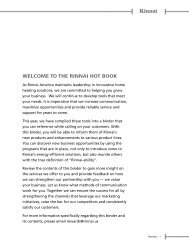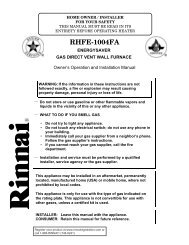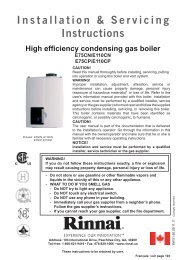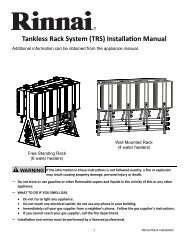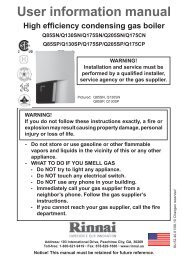Direct Vent Tankless Water Heater - Rinnai
Direct Vent Tankless Water Heater - Rinnai
Direct Vent Tankless Water Heater - Rinnai
You also want an ePaper? Increase the reach of your titles
YUMPU automatically turns print PDFs into web optimized ePapers that Google loves.
<strong>Vent</strong>ing Instructions<br />
Intake / Exhaust Guidelines<br />
• This water heater is a direct vent water heater and<br />
therefore is certified and listed with the vent<br />
system. You must use vent components that are<br />
certified and listed with the water heater model.<br />
• Do not combine vent components from different<br />
manufacturers.<br />
• The vent system must vent directly to the outside<br />
of the building and use outside air for combustion.<br />
• <strong>Vent</strong>ing should be as direct as possible with a<br />
minimum number of pipe fittings.<br />
• Avoid dips or sags in horizontal vent runs by<br />
installing supports per the vent manufacturer’s<br />
instructions.<br />
• Support horizontal vent runs every four feet and all<br />
vertical vent runs every six feet or in accordance<br />
with local codes.<br />
• <strong>Vent</strong> diameter must not be reduced.<br />
• Do not connect the venting system with an existing<br />
vent or chimney.<br />
Condensate<br />
Condensate formation can occur in high efficiency<br />
direct vent appliances. To prevent condensate<br />
damage follow these instructions.<br />
• Vertical terminations must incorporate a<br />
condensate drain and trap as close as possible to<br />
the appliance.<br />
• RL75i, and RL94i water heaters have an integrated<br />
condensate collector.<br />
• <strong>Rinnai</strong> offers a condensate trap.<br />
• Regions of cold climate will create more<br />
condensate in the vent system. The condensate<br />
collector should be used in cold climates.<br />
• Use only vent that is approved and identified as<br />
acceptable for your particular model.<br />
• Do not use PVC, CPVC, ABS or galvanized<br />
material to vent this appliance.<br />
• Slope the venting toward the appliance according to<br />
the vent manufacturers installation instructions.<br />
• All condensate must drain and be disposed of per<br />
local codes.<br />
• Use only PVC or CPVC pipe for the condensate<br />
drain line.<br />
• The condensate drain pipe should be as short as<br />
possible and have a downward pitch.<br />
• Do not connect the condensate drain pipe directly<br />
to the rain sewer.<br />
Refer to the specific instructions on your vent product for additional<br />
installation requirements.<br />
26 VB Series Indoor LS Manual<br />
• Do not common vent with the vent pipe of any<br />
other water heater or appliance.<br />
• <strong>Vent</strong> connections must be firmly pressed together<br />
so that the gaskets form an air tight seal.<br />
• RL75i, RL94i: The vent piece connected to the<br />
water heater must be secured with one self-tapping<br />
screw.<br />
• Refer to the instructions of the vent system<br />
manufacturer for component assembly instructions.<br />
• If the vent system is to be enclosed, it is suggested<br />
that the design of the enclosure shall permit<br />
inspection of the vent system. The design of such<br />
enclosure shall be deemed acceptable by the<br />
installer or the local inspector.<br />
NOTICE<br />
If it becomes necessary to access an enclosed vent<br />
system for service or repairs, <strong>Rinnai</strong> is not responsible<br />
for any costs or difficulties in accessing the vent<br />
system. Warranty does not cover obtaining access to<br />
an enclosed vent system.<br />
WARNING<br />
The condensate trap must be primed before operation<br />
to prevent exhaust gases from entering the building.<br />
NOTICE<br />
Provisions must be made to prevent the condensate<br />
from entering the water heater. Without proper<br />
drainage or disposal, condensate will damage the heat<br />
exchanger.<br />
Do not plug or cap the integrated condensate line.<br />
Without proper drainage or disposal, condensate will<br />
damage the water heater.<br />
• The condensate drain pipe (along its entire length)<br />
must be at least the same diameter as the drain<br />
line, (3/8 inch NPT).<br />
• The end of the condensate drain pipe should be<br />
open to the atmosphere. The end should not be<br />
under water or other substances.<br />
• Do not connect the condensate drain line with an<br />
air conditioning evaporator coil drain.<br />
• To minimize freezing of the condensate, run the<br />
condensate drain line through an interior wall or<br />
between insulation and an interior wall.<br />
• The condensate collector should be used for all<br />
hydronic heating applications.



